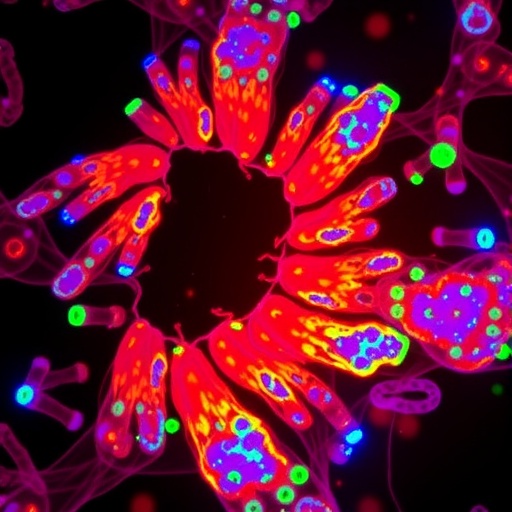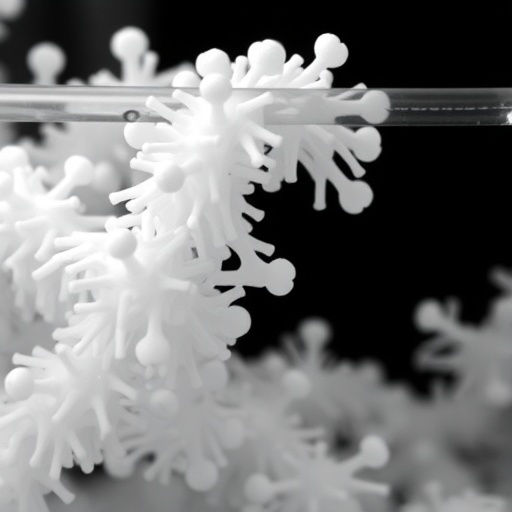In a groundbreaking advancement that bridges the elusive divide between genetic mutations and their phenotypic manifestations, researchers have unveiled a pioneering technique that leverages holo-tomographic flow cytometry to decode cellular blasts at unprecedented resolution. This cutting-edge study, recently published in Light: Science & Applications, heralds a new era in real-time cellular analysis, transforming our capacity to comprehend the complex genotype-to-phenotype relationship that remains a cornerstone challenge in molecular biology and personalized medicine.
At the heart of this innovation lies holo-tomographic flow cytometry, a fusion of holographic microscopy and flow cytometry technologies. This hybrid approach harnesses the power of label-free, three-dimensional imaging while simultaneously maintaining the high-throughput capabilities necessary for analyzing large populations of cells. By marrying these techniques, the research team has surpassed conventional limitations, enabling detailed visualization of cellular morphology and dynamics directly linked to underlying genetic mutations.
The process begins with the interrogation of cellular blasts—immature cells often implicated in hematologic disorders and malignancies—under holo-tomographic conditions that reconstruct their three-dimensional refractive index distributions. These reconstructions provide quantitative biophysical information such as cell volume, intracellular density distributions, and nuclear-cytoplasmic ratios without resorting to fluorescent or chemical staining, which often alters cellular physiology or limits temporal resolution.
.adsslot_aFsLZAuzTp{ width:728px !important; height:90px !important; }
@media (max-width:1199px) { .adsslot_aFsLZAuzTp{ width:468px !important; height:60px !important; } }
@media (max-width:767px) { .adsslot_aFsLZAuzTp{ width:320px !important; height:50px !important; } }
ADVERTISEMENT
Conventional flow cytometry has long been relied upon for sorting and classifying cells based on surface markers and fluorescence-labeled antibodies. However, its inability to capture intrinsic cellular properties without exogenous labels presented a bottleneck in discerning subtle phenotypic consequences of mutations. By integrating holographic imaging, the method captures intrinsic optical properties of the cells, transforming the flow cytometer from a marker-dependent sorting tool to a comprehensive phenotypic decoder.
One of the study’s core achievements is the direct linking of genotype—specific mutation profiles—with distinct phenotypic fingerprints observed through the holo-tomographic readouts. Using advanced computational algorithms, the researchers decoded alterations in cellular refractive indices that correlated with particular mutations found in blast cells. Such precise phenotypic mapping opens avenues for swift and non-invasive diagnosis, stratification, and monitoring of diseases characterized by cellular mutations, especially cancers and blood disorders.
The implications extend far beyond diagnosis. Understanding how specific mutations alter cellular structure and behavior in real time fosters a granular view of disease progression and response to therapies. For instance, the ability to detect subtle changes in intracellular density distributions or nuclear morphology could predict cellular resistance to chemotherapy, enabling preemptive adjustments to treatment regimens tailored to individual patients.
Moreover, the technique’s label-free nature offers significant advantages for clinical applications. Avoiding fluorescent dyes or genetic tagging reduces cellular perturbations and toxicity, preserving the authentic phenotype. This facilitates longitudinal studies on the same cellular populations, crucial for monitoring dynamic changes in heterogeneous cell communities, such as cancer stem cells or immune cell subsets responding to immunotherapies.
The researchers also meticulously optimized the flow conditions and holographic reconstruction algorithms to ensure rapid data acquisition without compromising spatial resolution. This breakthrough allows processing of thousands of cells per minute, rivaling traditional flow cytometry throughput while adding the unprecedented dimension of holistic cellular morphology. Such scalability paves the way for implementation in clinical laboratories where swift turnaround times are essential.
From a technological standpoint, the integration demanded sophisticated hardware innovations. The flow cytometer was equipped with a coherent light source configured for digital holographic imaging, along with high-speed cameras capable of capturing interference patterns generated by flowing cells. State-of-the-art GPU-accelerated software reconstructed three-dimensional refractive indices in milliseconds, enabling real-time phenotypic assessments.
The successful decoding of mutations at the phenotype level also underscores the potential for machine learning models to further enhance cell classification. By training algorithms on the holo-tomographic datasets, it becomes feasible to detect otherwise imperceptible patterns predictive of mutational status, disease progression, or therapeutic outcomes. This synergy between optics and artificial intelligence embodies the future of precision diagnostics.
Importantly, the study’s methodology is not limited to blast cells. The platform’s versatility allows adaptation to a variety of cell types and states, encompassing stem cells, immune effectors, and circulating tumor cells. This universality suggests broad applicability across biomedical research and clinical diagnostics, potentially revolutionizing how cells are studied and categorized based solely on intrinsic physical properties.
While the research signifies a leap forward, challenges remain in translating this technology to routine clinical workflows. Standardization of holographic reconstructions across diverse instruments and biological samples is essential to ensure reproducibility and reliability. Additionally, integrating the phenotypic data with genomic and proteomic information will require sophisticated data management strategies and interpretative frameworks.
Nevertheless, the envisioned future is compelling. Imagine a clinic where a simple blood draw undergoes holo-tomographic flow cytometry, instantly revealing mutational landscapes and phenotypic states that guide therapeutic decisions with unmatched precision. By converting genotype information into easily interpretable phenotypic signatures, clinicians could target therapies more effectively, reduce side effects, and enhance patient outcomes.
This study exemplifies the power of interdisciplinary innovation, blending optics, computational science, and cellular biology to confront one of the most intricate puzzles in life sciences. Its impact will resonate deeply within oncology, hematology, and regenerative medicine, paving the way for personalized, real-time cellular phenotyping that was previously inconceivable.
In conclusion, holo-tomographic flow cytometry marks a transformative milestone in decoding the complexities of cellular mutations and their phenotypic expressions. The method’s ability to analyze thousands of cells in a label-free, non-invasive manner while providing rich biophysical data sets a new paradigm in cellular diagnostics. As further refinements emerge and clinical validations proceed, this technology promises to reshape our approach to understanding and treating diseases rooted in genetic mutations.
The future glimpsed by this research is one where cellular phenotypes serve as transparent windows into the mutational mechanisms driving disease, observable in real time without disrupting cellular integrity. Such clarity will empower a new generation of precision medicine, informed by the subtle language of refractive indices and holographic images, ultimately revolutionizing patient care on a global scale.
Subject of Research: Decoding cellular mutations and linking genotype to phenotype using holo-tomographic flow cytometry.
Article Title: From genotype to phenotype: decoding mutations in blasts by holo-tomographic flow cytometry.
Article References:
Pirone, D., Di Natale, C., Di Summa, M. et al. From genotype to phenotype: decoding mutations in blasts by holo-tomographic flow cytometry. Light Sci Appl 14, 233 (2025). https://doi.org/10.1038/s41377-025-01913-y
Image Credits: AI Generated
DOI: https://doi.org/10.1038/s41377-025-01913-y
Tags: biophysical information in cellscellular blasts analysisdecoding genetic mutationshematologic disorders researchhigh-resolution cellular imagingholo-tomographic flow cytometrylabel-free imaging technologiesmolecular biology advancementsnovel cytometry methodspersonalized medicine innovationsphenotype manifestation techniquesthree-dimensional cell imaging






